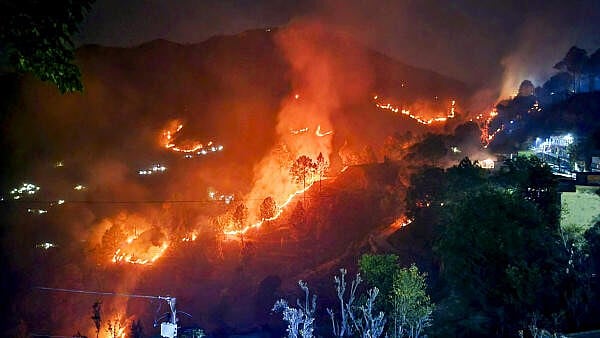
Flames rise during a forest fire near Saterakhal village, in Rudraprayag district, Uttarakhand, Wednesday, April 24, 2024.
Credit: PTI
Massive fire has encompassed Uttarakhand's forests. Efforts have been intensified to extinguish the raging forest fires in the state, especially in the worst-affected areas of Nainital, Haldwani and Ramnagar forest divisions, forest officials told news agency PTI.
On Sunday, Indian Air Force (IAF) was engaged in firefighting operations in Nainital district.
As of now, the cause of the fire is unknown but let's take a look at the potential causes of forest fires and see how frequent these are in India.
Potential causes of forest fire
Firefighters try to douse the flames after a fire broke out in a forest area, in Almora, Uttarakhand.
Credit: PTI
Owing to the change in agriculture and unchecked land-use patters, most forest fires are believed to be man-made.
Four reasons that can cause a forest fire have been mentioned by the forest department. These include deliberate fires by locals, carelessness, farming-related activities, and natural reasons.
Furthermore, a government report states that locals in Uttarakhand deliberately set forests on fire for good quality of grass, poaching, to cover up illegal deforestation, and more. The report also states that the friction of electricity cables with dry leaves can be a cause for wildfires.
According to the Indian Penal Code, setting a forest on fire is a punishable offence. A forest officer told the Indian Express that several cases have been lodged but the accused often remains unidentified in such cases.
How are these fires prevented
An Mi-17 V5 helicopter of the Indian Air Force conducts a 'Bambi Bucket Operation' to control the fire that broke out in the forests of Kumaon division, in Nainital district of Uttarakhand.
Credit: PTI
Four methods are labelled by the Ministry of Environment, Forest and Climate Change (MoEFCC) to prevent and control forest fires—watch towers' construction for early detection, fire watchers' deployment; local communities' involvement, and creation and maintenance of fire lines.
National Disaster Management Authority (NDMA) website, labels two types of fire lines - Kachha and Pucca.
In Kachha or covered fire lines, undergrowth and shrubs are removed and trees are retained to decrease the fuel load.
Pucca or open fire lines are clear-cut areas that separating forest, its compartment or block from another in order to control the spread of potential fires.
The Forest Survey of India (FSI) website further states, "Satellite based remote sensing technology and GIS tools have been effective in better prevention and management of fires through creation of early warning for fire prone areas, monitoring fires on real time basis and estimation of burnt scars.”
On Sunday, an Mi-17 V5 helicopter was deployed in Nainital and surrounding areas to douse the flames.
How frequent are these fires in India
Visuals of forest fire from Himachal Pradesh, Karnataka, Delhi, Uttarakhand, Jammu and Jharkhand.
Credit: PTI Photos
Typically, India's forest fire season lasts between November to June. FSI website states that nearly 36 per cent forests in India are prone to fires.
Temperatures, precipitation, vegetation, and moisture also contribute to the frequency of these fires. Experts say that fuel load, oxygen and temperature also cause these fires.
Fire incidents in the country are mainly reported during the months of March, April, and May due to the availability of dry biomass after the end of winter and prior to summer, IE noted.
“Severe fires occur in many forest types particularly dry deciduous forest, while evergreen, semi-evergreen and montane temperate forests are comparatively less prone (India State of Forest Report 2015)… Nearly 4 per cent of the country’s forest cover is extremely prone to fire, whereas 6 per cent of forest cover is found to be very highly fire prone (ISFR 2019)", FSI website further states.
In its 2021 report, FSI found out that states in the northeast have higher tendency for forest fires. Moreover, parts of western Maharashtra, central Odisha, southern Chhattisgarh, regions in Karnataka, Telangana and Andhra Pradesh also have showed the prevalence of fire-prone zones.
